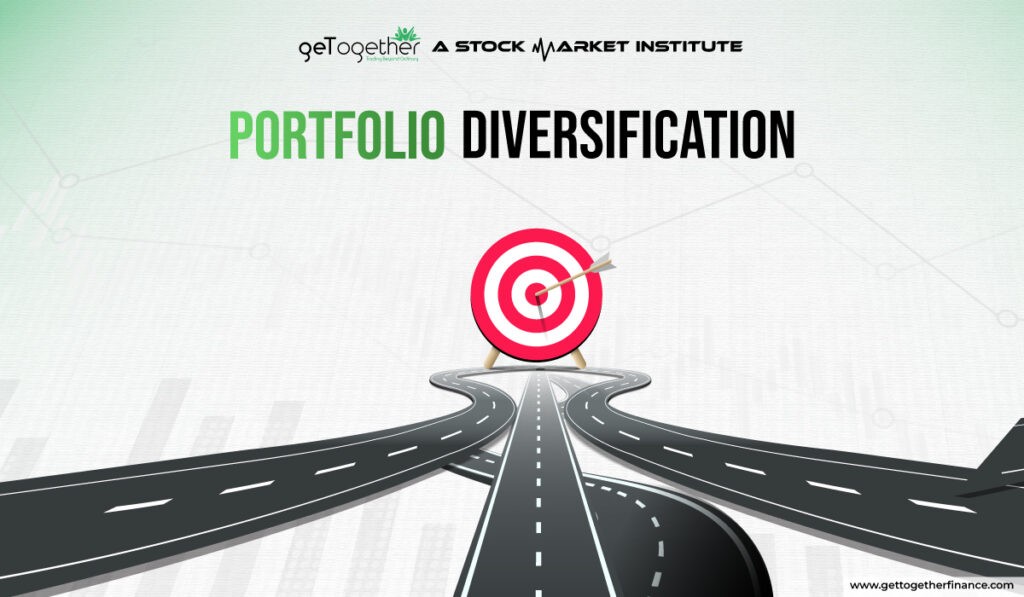Portfolio Diversification
- May 6, 2024
- 2960 Views
- by Manaswi Agarwal


Portfolio Diversification is a strategy beneficial for investors to segregate their investments into different categories. Basically, diversifying your portfolio means dividing your investments into different sectors. An investor can efficiently manage the risk by distributing the risks in different types of assets. Investors, who hold onto for a long time period, focus on adopting this strategy as it prepares them for future fluctuations in the stock market. Portfolio diversification strategy prevents investors from market volatility in the long term.
Table of Contents
ToggleWhat is Portfolio Diversification?

A diversified portfolio is maintained through a well planned diversifying investment strategy which includes a mix of various asset classes, foreign assets, etc. Putting all your investment in a single asset never balances the risk and reward ratio of an investor. It is mainly done to avoid industry specific risks. Let’s say if you put all the money in the real estate sector, if there is a downfall in the sector then the portfolio will become negative, on the other hand if the investment is spread across different sectors then losses can be managed.
What are the benefits of portfolio diversification?

Portfolio Diversification acts as a safeguard to any kind of sector specific risks. Underperformance of a single sector does not affect the overall portfolio because of diversification. An investor can explore multiple approaches by diversifying their portfolios from value focused to growth focused investing. Investors become less vulnerable to market volatility in the long term. It is necessary to diversify your portfolio in order to bring down the overall risk. This allows the investor to learn about different investment choices and get well known with different market situations.
Risk Management
Diversification of portfolio reduces overall portfolio risks as the investments are spread across different sectors and asset classes. It helps to manage the risk as poor performance of a single asset does not affect the entire portfolio. When you have segregated your investment in media and banking sectors then the bad performance of the media sector will not affect the overall portfolio as the investment in the banking sector would be there to balance it.
Good Returns
Diversifying your portfolio ensures stable and secure returns over a long time period. If the portfolio is balanced between various asset classes helps investors to experience good returns as the risk is balanced. Small portions of returns in each sector can result in building a great portfolio and hence generate good returns in the long term.
Growth Prospects
Investors can generate long term wealth by investing into different assets and not being dependent on a single asset for returns. Long term returns are accumulated in the portfolio as an impact of compounding returns over time.
Methods of Portfolio Diversification

There are two methods of portfolio diversification i.e. direct investing and indirect investing. Direct Investing is to buy or sell individual securities like stocks and bonds by incurring the brokerage costs, transaction costs and taxes. In direct investing, an investor has to dedicate time toward research and gain expertise. On the other hand, indirect investing is a method of buying or selling pooled funds such as mutual funds, exchange-traded funds (ETFs) while tracking specific themes, sectors, or indexes. This actually means to invest in a sector as a whole instead of a single stock. For example, in direct investing you buy a single stock like PNB as per your strategy while indirect investing means to invest the amount in PSU Bank sector through ETFs which includes different stocks and hence balance your portfolio.
How to build a diversified portfolio?

To diversify your portfolio, an investor is obliged to make strategies by gaining knowledge about the stock or with the help of a financial advisor. The strategies adopted to maintain a diversified portfolio must be followed strictly in order to gain maximum profits. You can go through these key steps to create a well-diversified portfolio.
Diversification across different asset classes
Diversify your portfolio across different asset classes which mean that the investments are spread across equities, bonds (fixed-income investments), cash, real estate, etc. Diversifying portfolios across different asset classes will maintain a balanced portfolio. Investors must spread their investment across at least two different asset classes for better returns.
Diversification Based on Sectors
Diversifying your portfolio within different asset classes means when you make investments in stocks, diversify them based on sectors. Investors can segregate their investments in various sectors such as FMCG, IT, Realty, PSU Banks, Media, Pharmaceuticals, etc. With the help of a mentor or a financial advisor, the investments in stock must be spread in various industries to avoid industry specific risks.
Also Read: Sector Analysis
Global Investments
While building your portfolio as an investor, you can follow portfolio diversification by investing globally to deal with country specific risks. Investing globally involves making investments in foreign assets such as in stocks and bonds of global companies.
Regular Portfolio Management
To build a well-diversified portfolio, regular management of the portfolio is required to enter and exit the securities at the right time. You should consider rebalancing your portfolio frequently to deal with situations that require immediate attention. An investor has to keep regular updates about major events that can have a major impact on their portfolio and take effective decisions in the portfolio.
Things to consider:
It is not always assured that diversifying your portfolio will always result in giving profits. Though it is recommended to prevent huge losses, portfolio diversification can play a major role to keep your investments safe. Investors should never over diversify their portfolio which can lead to giving overall negative returns. You should have a proper balance of assets with appropriate diversification to generate best possible returns.
On a Closing Note
In a nutshell, you should diversify your portfolio as an effective investment strategy and manage it regularly for increased returns. It also has a limitation because diversifying does not guarantee profits always because a downfall can occur at any time. A professional financial advisor or mentor can help you guide better about managing your portfolio.
FAQs
Q1. What is a diversified portfolio?
A diversified portfolio is an investment strategy to spread the risks among different assets to balance the portfolio and gain maximum returns.
Q2. How to maintain a diversified portfolio?
To maintain a diversified portfolio, an investor must follow the advice of a financial advisor who has years of experience and guides you to maintain the portfolio smoothly.
Q3. What are the common mistakes to avoid in portfolio diversification?
Investors must avoid common mistakes such as over-diversification of portfolio, ignoring the associated costs, not giving enough attention and various others.
Q4. How to diversify the portfolio?
An investor must diversify the portfolio by spreading their investment into different assets like stocks, bonds, foreign investments, etc.
Q5. What is the minimum amount required for investment?
An investor can invest as per their requirement and strategy for that they are not required to fulfill minimum requirements.



 Instagram
Instagram
